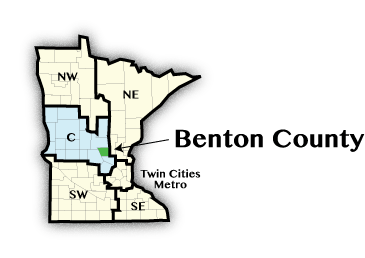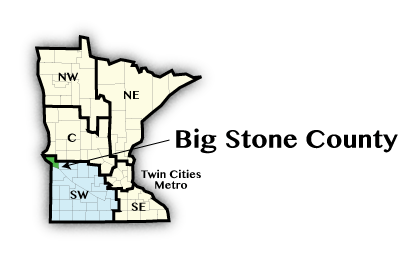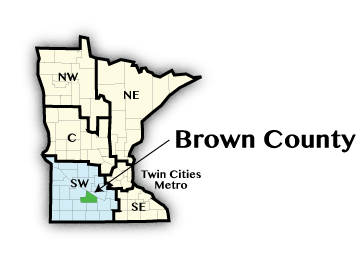by Chet Bodin
May 2017

Benton County was one of the original nine counties established by the territorial legislature in 1849 and was one of the three which were declared organized. The county was named in honor of Thomas Hart Benton, a senator from Missouri, who worked diligently to have Congress enact the Homestead Act. It is one of nine counties named after Mr. Benton in the United States.
In 2017 Benton County became one of the primary sites for the Industrial Hemp Pilot Project through the Minnesota Department of Agriculture. The average hemp grain yield in Minnesota in 2016 was 1,334 pounds of grain per acre1, making the crop a potentially lucrative and environmentally friendly alternative for small land holders in rural parts of Benton County.
| Economy | ||
|---|---|---|
| 2016 Estimates | Benton | Minnesota |
| Population | 39,992 | 5,489,594 |
| Labor Force | 21,540 | 2,990,254 |
| Average Unemployment | 4.5% | 3.9% |
| Average Annual Income | $39,818 | $54,457 |
| Cost of Living, Individual | $27,039 | $30,084 |
| Cost of Living, Average Family | $45,782 | $80,976 |
| Source: DEED Local Area Unemployment Statistics, Cost of Living; U.S. Census Bureau, 2016 American Community Survey | ||
| Industry | |||||
|---|---|---|---|---|---|
| Benton | Top Industries of Employment | Total 2015 Employment | Percent Change 2006-2015 | Average Annual Wages | Percent Change 2006-2015 |
| Total, All Industries | 16,861 | 1.2% | $38,605 | 20.9% | |
| 1 | Manufacturing | 3,567 | -28.4% | $45,994 | 8.9% |
| 2 | Trade, Transportation, and Utilities | 3,472 | 5.9% | $38,431 | 33.3% |
| 3 | Education and Health Services | 3,306 | 19.2% | $30,665 | 21.9% |
| 4 | Construction | 1,826 | 55.7% | $56,793 | 46.3% |
| Source: DEED Quarterly Census of Employment and Wages 2006-2015 | |||||
Manufacturing remained the industry with the highest employment in Benton County, despite shedding nearly 1,500 jobs since 2006, a 28.4 percent decline since before the recession. However, other industries in Benton County are picking up the slack. Notable, Construction jobs increased by 55.7 percent (up 653) since 2006, led by a significant increase of 495 in Heavy and Civil Engineering Construction jobs. In addition, average annual wages in Construction have surpassed those in Manufacturing, although wages in both industries increased since 2006. Like most of Minnesota, a large part of the Benton County population is entering retirement age and in need of more healthcare, leading to more jobs in Education and Healthcare Services, an increase of 533. Almost 400 of these jobs were added in Nursing and Residential Care Facilities.
1Morris Tribune, Agriculture

Big Stone County was founded in 1862, but remained unorganized until 1881. Big Stone is the English translation for the Dakota Indian word for outcrops of granite and gneiss found in nearby Minnesota Valley. So widespread are the granite deposits that Big Stone County has become one of the leading granite mining areas in the United States. The county's first known granite quarry, the Baxter Quarry, was in operation as early as 1886.2
In 2015 the Federated Telephone Cooperative in Big Stone County raised $7.92 million to construct broadband infrastructure, in part from DEED's Border to Border Broadband Development Grant Program. The ongoing project has brought broadband service to over 1,072 unserved areas in and around the cities of Ortonville, Barry, Beardsley, and Johnson. This investment has potential to bring more professional services to Big Stone County and provides the technological basis for future growth throughout the local economy.
| Economy | ||
|---|---|---|
| 2016 Estimates | Big Stone County | Minnesota |
| Population | 5,050 | 5,489,594 |
| Labor Force | 2,718 | 2,990,254 |
| Average Unemployment | 4.9% | 3.9% |
| Average Annual Income | $37,104 | $54,457 |
| Cost of Living, Individual | $25,162 | $30,084 |
| Cost of Living, Average Family | $42,309 | $80,976 |
| Source: DEED Local Area Unemployment Statistics; Cost of Living; U.S. Census Bureau, 2016 American Community Survey | ||
| Industry | |||||
|---|---|---|---|---|---|
| Big Stone | Top Industries of Employment | Total 2015 Employment | Percent Change 2006-2015 | Average Annual Wages | Percent Change 2006-2015 |
| - | Total, All Industries | 1,753 | -8.9% | $36,528 | 50.9% |
| 1 | Education and Health Services | 739 | -0.1% | $36,417 | 42.7% |
| 2 | Trade, Transportation, and Utilities | 335 | 2.8% | $34,007 | 52.6% |
| 3 | Construction | 193 | 8.4% | $59,771 | 58.5% |
| 4 | Public Administration | 154 | -16.8% | $40,649 | 39.5% |
| Source: DEED Quarterly Census of Employment and Wages 2006-2015 | |||||
Over 42 percent of employment in Big Stone County is found in Education and Health Services, although there has not been much change in the number of jobs in these fields since 2006. Wages, on the other hand, have increased dramatically across all the major industries in Big Stone County. This is likely an attempt to keep up with the competition for workers as the labor market tightens. Already, there are nearly 200 fewer jobs in Big Stone County than there were 10 years ago. Recent investments in broadband aim to spur growth and grab the attention of future job-seekers and entrepreneurs.
2Prairie Waters Visitors Guide

Blue Earth County saw great growth near the end of the 19th Century and has developed into a major part of Minnesota's economy. Originally a major railroad thoroughfare, some of the first industries included milling, transportation, and agriculture. Private and public post-secondary educational institutions have been established in Blue Earth County since then, adding a healthy dose of culture and social capital to the area. Consequently, the mix of industries and people in the county resulted in a population increase of 48 percent between 1950 and 2015.
Over 86 acres of former quarry land near downtown Mankato are part of the city and county redevelopment plans for the coming years. The broader community of residents and business owners have discussed using the property for a high-tech business park, a mountain biking park, or even a drive-in movie theatre3. Regardless, the new development is sure to change the composition of Blue Earth County's largest city and has the potential to bring many new jobs to the area
| Economy | ||
|---|---|---|
| 2016 Estimates | Blue Earth County | Minnesota |
| Population | 66,441 | 5,489,594 |
| Labor Force | 39,471 | 2,990,254 |
| Average Unemployment | 3.2% | 3.9% |
| Average Annual Income | $40,922 | $54,457 |
| Cost of Living, Individual | $26,827 | $30,084 |
| Cost of Living, Average Family | $45,080 | $80,976 |
| Source: DEED Local Area unemployment Statistics; Cost of Living; U.S. Census Bureau, 2016 American Community Survey | ||
| Industry | |||||
|---|---|---|---|---|---|
| Blue Earth | Top Industries of Employment | Total 2015 Employment | Percent Change 2006-2015 | Average Annual Wages | Percent Change 2006-2015 |
| - | Total, All Industries | 38,666 | 5.6% | $40,036 | 22.0% |
| 1 | Education and Health Services | 12,011 | 21.9% | $44,913 | 22.9% |
| 2 | Trade, Transportation, and Utilities | 8,735 | 1.4% | $31,117 | 23.4% |
| 3 | Leisure and Hospitality | 4,114 | 11.5% | $13,344 | 37.7% |
| 4 | Manufacturing | 3,703 | -1.2% | $54,028 | 35.9% |
| Source: DEED Quarterly Census of Employment and Wages 2006-2015 | |||||
Unsurprisingly, Education and Health Services is the leading industry in terms of employment in Blue Earth County, both of which account for a higher portion of jobs in the county than they do statewide. Growth in the combined sector was over 21 percent since 2006. Leisure and Hospitality also contributed to the economic recovery in Blue Earth County, growing by over 11 percent since its pre-recession level. Average annual wages grew in most industries throughout the county, led by Manufacturing where the average annual wage increased from $39,761 in 2010 to $54,028 in 2016 – a 35.9 percent hike. Often overshadowed by education institutions in the region, Manufacturing is not typically identified with Blue Earth County, but it continues to provide a sustainable income for many of its long-term residents.

Much of Brown County was established in the mid-nineteenth century by German settlers to take advantage of the fertile Minnesota River Valley and burgeoning railroad economy. In additional to agriculture and stock, some of the first family breweries in the nation were started in Brown County's largest city, New Ulm. By 1916 the brewing industry in Brown County employed over 70 people in the New Ulm area and produced approximately 30,000 barrels per year.4
Although it isn't one of the top industries in terms of employment, the New Ulm Chamber of Commerce notes that over 53 percent of the economy is still related to agriculture. Animal production in particular remains one of the most influential industries in Brown County. The New Ulm Economic Development Authority recently reported a new hog processing plant is expected to employ 1,100 people in the area by 2020.5
| Economy | ||
|---|---|---|
| 2016 Estimates | Brown County | Minnesota |
| Population | 25,331 | 5,489,594 |
| Labor Force | 14,755 | 2,990,254 |
| Average Unemployment | 4.1% | 3.9% |
| Average Annual Income | $39,618 | $54,457 |
| Cost of Living, Individual | $23,450 | $30,084 |
| Cost of Living, Average Family | $41,240 | $80,976 |
| Source: DEED Local Area Unemployment Statistics; Cost of Living; U.S. Census Bureau, 2016 American Community Survey | ||
| Industry | |||||
|---|---|---|---|---|---|
| Brown | Top Industries of Employment | Total 2015 Employment | Percent Change 2006-2015 | Average Annual Wages | Percent Change 2006-2015 |
| - | Total, All Industries | 13,828 | -2.6% | $38,710 | 29.4% |
| 1 | Education and Health Services | 3,088 | 5.5% | $36,844 | 32.4% |
| 2 | Trade, Transportation, and Utilities | 2,786 | 3.8% | $31,011 | 25.2% |
| 3 | Manufacturing | 2,783 | -24.0% | $51,308 | 30.8% |
| 4 | Leisure and Hospitality | 1,158 | -5.2% | $12,114 | 27.9% |
| Source: DEED Quarterly Census of Employment and Wages 2006-2015 | |||||
Currently (2016 Q3), employment in animal production was over 10 times more prevalent in Brown County than the rest of the state. Self-employed individuals in Agriculture, Forestry, Fishing, and Hunting also increased between 2010 and 2014 in Brown County. Manufacturing has shed jobs in Brown County since 2006, but wages have increased by over 30 percent to an average of $51,308 annually for its employees. In fact, wages in all industries have increased by almost 30 percent across Brown County since 2006 while the cost of living for an average family in Brown County is almost half of what it costs in Minnesota on average.
4History of Brown County, Minnesota: Its People, Industries and Institutions; Fritsche, L.A. 1916. Walsworth. History of Brown County, Minnesota
5The Journal: New Ulm development officials work to recruit prospects